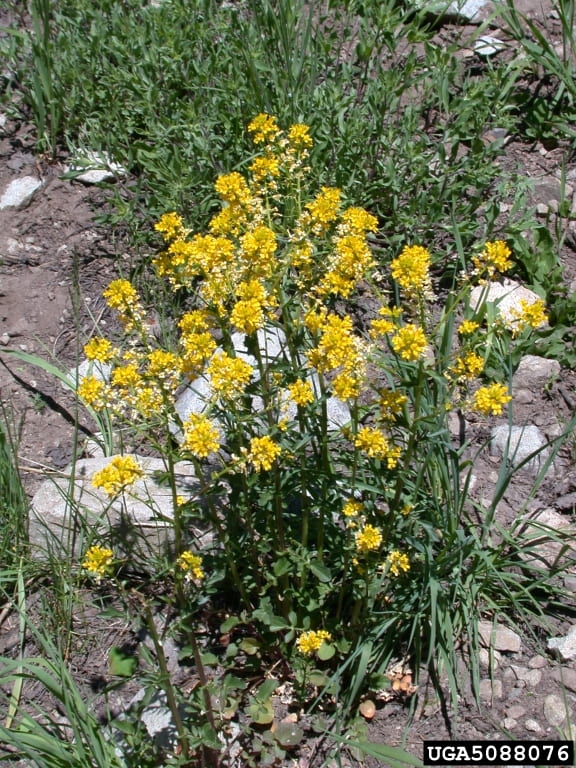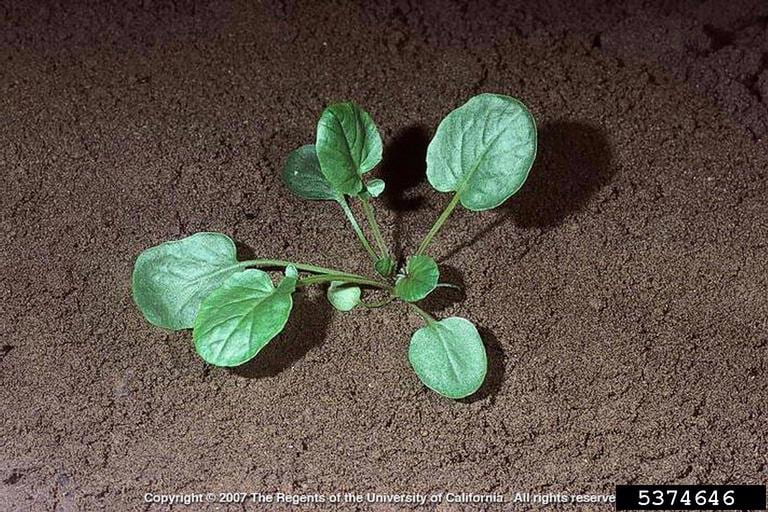Yellow rocket (Barbarea vulgaris) is a weed in the mustard family which normally grows as a winter annual or biennial (occasionally a perennial). It is a common weed of pastures, small grains, landscapes and nursery crops in New York. As a fall-emerging species, it is a problem in fall-seeded crops like overwintering grains or fall-seeded alfalfa. Heavy grazing of livestock on yellow rocket can cause digestive irritation, similar to other Brassica species.
Yellow rocket is one of 3000+ species in the mustard family, some of which can be hard to tell apart. For help identifying weedy mustards, please visit our mustard identification page.
Identification
Seedlings: Yellow rocket cotyledons are egg-shaped to round with a slightly-notched apex and a long stem. Early leaves are round with a heart-shaped base and wavy or entire margins. As the leaves mature their edges become distinctly toothed. Emerging seedlings grow into dense basal rosettes with leaves that are alternately arranged.
Leaves: Mature leaves are dark green, thick, and glossy. Basal rosette leaves are smooth, glossy, and 5-20 cm (2-8”) long, with 1-5 smaller, opposite-facing lobes and a larger terminal lobe with a heart-shaped base, rounded tip, and wavy toothed edges. Leaves growing on the stem are alternate, and become shorter along the length of the plant.
Mature yellow rocket basal leaves
Photo by Bruce Ackley of The Ohio State University via Bugwood.org
Mature plant: First year plants remain as rosettes, with flowering stems emerging in the second year. Mature plant stems are smooth, ridged or angular, and simple or branched towards the top of the plant. Flowers emerge in early spring and sporadically throughout the summer. Yellow rocket is taprooted.
Flowers/Fruit: Bright yellow flowers develop on racemes in pyramidal clusters. Each flower consists of 4 petals, 4 sepals, and 6 stamens. The four-sided fruits (siliques) are ~2.5 cm (1″) long and 2.3mm (1/10″) wide, held on 3-6 mm (up to 1/4”) stalks (pedicels). Fruits split lengthwise into 2 long sections when the seeds inside are ripe.
Management
Chemical control
New York specific guidance can be found in the Cornell Crop and Pest Management Guides, or click above for the chemical control of yellow rocket from Cornell’s turfgrass and weed weed identification app.
Non-chemical control
Because this is weed often emerges in the fall, fall and early winter are a good time to target yellow rocket for management. This weed can be managed with a normal fall-emerging weed management routine. Early weeds are readily uprooted, but established plants are more difficult due to the taproot.
Species Similar to Yellow Rocket
Table 1: Shows yellow rocket (Barbarea vulgaris) similarities and differences in identification compared to its similar species .| Species | Similarities | Differences |
|---|---|---|
| Wild radish (Raphanus raphanistrum) | dark green leaves, yellow flowers | hairy leaves, flowers turn white with age, leaves do not clasp the stem |
| Wild mustard (Brassica kaber) | dark green leaves that clasp the stem, yellow flowers | hairy leaves |
References
Uva R H, Neal J C, DiTomaso J M. 1997. Weeds of the Northeast. Book published by Cornell University, Ithaca NY. The go-to for weed ID in the Northeast; look for a new edition sometime in 2019.
Cornell University’s Turfgrass and Landscape Weed ID app. Identification and control options for weeds common to turf, agriculture, and gardens in New York; uses a very simple decision tree to identify your weed.
University of California, Davis’s A Weed Report from Weed Control in Natural Areas in the Western United States. Identification and management descriptions for yellow rocket.
A Mustard Identification Workshop page by Tim Miller for the Washington State Weed Conference. Identification information on mustard weeds.
Lyon D, Burke I, Campbell J. Integrated Management of Mustard Species in Wheat Porduction Systems. A Pacific Northwest Extension Publication from a collaboration between Washington State University, Oregon State University, and University of Idaho.









